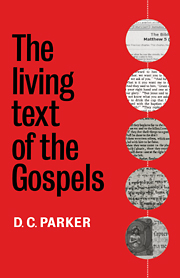Book contents
- Frontmatter
- Contents
- Preface
- List of abbreviations and frequently cited works
- 1 The theory
- 2 The materials
- 3 The practice
- 4 ‘As our Saviour taught us …’: the Lord's Prayer
- 5 The sayings on marriage and divorce
- 6 The story of the woman taken in adultery
- 7 Secrets and hypotheses
- 8 The endings of Mark's Gospel
- 9 The last three chapters of Luke
- 10 The development and transmission of the Fourth Gospel
- 11 From codex to disk
- 12 The living text
- Index of citations
- Index of Greek New Testament manuscripts
- Index of names and subjects
8 - The endings of Mark's Gospel
Published online by Cambridge University Press: 05 June 2012
- Frontmatter
- Contents
- Preface
- List of abbreviations and frequently cited works
- 1 The theory
- 2 The materials
- 3 The practice
- 4 ‘As our Saviour taught us …’: the Lord's Prayer
- 5 The sayings on marriage and divorce
- 6 The story of the woman taken in adultery
- 7 Secrets and hypotheses
- 8 The endings of Mark's Gospel
- 9 The last three chapters of Luke
- 10 The development and transmission of the Fourth Gospel
- 11 From codex to disk
- 12 The living text
- Index of citations
- Index of Greek New Testament manuscripts
- Index of names and subjects
Summary
Is this the promised end?
William Shakespeare, The History of King Lear and The Tragedy of King LearWe might suppose it to be invariably the case that a story has an ending, and that is that. But some recollection will suggest that we are familiar from various sources with the possibility of multiple endings. The fairy stories of the brothers Grimm often have variants. Is Red Riding Hood eaten by the wolf or does she live happily ever after? Greek myths are told and retold with different endings. In Gluck's opera, Eurydice is finally restored to Orfeo, even though he has looked back at her as he leads her out of Hades. Modern novels have extended the possibilities. John Fowles' The French Lieutenant's Woman gives us a choice of endings. Other books avoid telling us the ending, avoid closure.
Armed with the knowledge that there are more options than the so-called fairy-tale ending, let us turn to one of the most fought-over extensive variant readings, the ending of Mark's Gospel. There are six different endings attested.
1. The Short Ending. This consists of the first eight verses of the last chapter. Their authenticity is undisputed.
And when the sabbath was past, Mary Magdalene, and Mary the mother of James, and Salome, brought spices, so that they might go and anoint him. And very early on the first day of the week they went to the tomb when the sun had risen. […]
- Type
- Chapter
- Information
- The Living Text of the Gospels , pp. 124 - 147Publisher: Cambridge University PressPrint publication year: 1997



